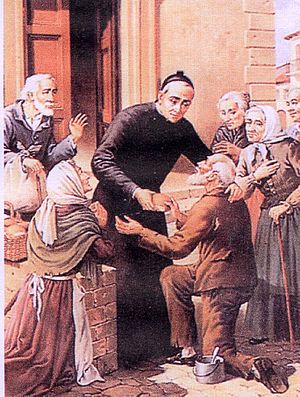Saturnino López Novoa facts for kids
Quick facts for kids VenerableSaturnino López Novoa |
|
|---|---|

Saturnino Lopez
|
|
| Priest | |
| Born | 29 November 1830 Sigüenza, Guadalajara, Spain |
| Died | 12 March 1905 (aged 74) Huesca, Spain |
| Venerated in | Roman Catholic Church |
| Attributes | Priest's cassock |
| Patronage | Hermanitas de los Ancianos Desamparados |
Saturnino López Novoa (born November 29, 1830 – died March 12, 1905) was a Spanish Catholic priest. He helped start a special group called the Hermanitas de los Ancianos Desamparados. He founded this group with Saint Teresa de Jesús Jornet e Ibars.
Saturnino lived with his aunt when he was a child. After he became a priest, he worked for his uncle. His uncle was a bishop in the Huesca area. Saturnino helped his uncle until his uncle passed away in Rome. This happened during a big meeting called the First Vatican Council. Saturnino was there to help his uncle with religious advice.
Even after his uncle died, Saturnino kept helping people. He cared for the poor and sick. He also worked hard to create new homes and places for his religious group. Many people in Huesca and Barbastro thought he was a saint. Because of this, a process began to recognize him officially. In 2014, Pope Francis said that Saturnino lived a life of great goodness. He was then given the title of Venerable.
Contents
Early Life and Education
Saturnino López Novoa was born in Sigüenza, Guadalajara, Spain. His birthday was November 29, 1830. He was the first of three children. His mother, Ildefonsa Novoa Bueno, died when he was five years old.
After his mother passed away, Saturnino went to live with his aunt Manuela. She lived in Berlanga de Duero. His aunt was a kind person. She often visited poor people and gave them bread she baked. Saturnino went with her on these visits. This taught him a lot about helping others.
In 1838, Saturnino and his aunt moved to live with his uncle Basilio Gil i Bueno. His uncle Basilio had become a priest in 1835. Around this time, Saturnino started studying Latin. He also received his First Communion and Confirmation around 1840.
Becoming a Priest
Saturnino began his studies to become a priest in 1842. In 1846, he received a scholarship. This allowed him to wear the cassock, which is a special robe for priests. He finished his studies in 1852. However, he was not old enough to become a priest yet.
He received several steps towards priesthood. On March 12, 1853, he received "minor orders." These are early steps in becoming a priest. He became a subdeacon in 1854 and then a deacon in June of the same year.
Finally, Saturnino was ordained as a priest on September 22, 1854. He celebrated his first Mass in October near Barbastro.
Working with his Uncle
In 1861, Saturnino's uncle, Basilio Gil i Bueno, became the Bishop of Huesca. His uncle asked Saturnino to be his personal helper. Saturnino helped him manage the church's affairs in the Huesca area. Saturnino was sad to leave Barbastro, but he went to Huesca to help his uncle.
Saturnino was with his uncle when he became a bishop on April 27, 1862. He also helped his uncle during the First Vatican Council in Rome. This was a very important meeting for the Catholic Church. Saturnino's uncle was not well, but he insisted on attending. Sadly, his uncle died in Rome on February 12, 1870.
Helping Others and Founding a Group
Saturnino founded several religious groups in Huesca. He also helped start the Hermanitas de los Ancianos Desamparados. He founded this group with his friend, Saint Teresa Jornet Ibars. The first home for this group opened on January 27, 1873, in Barbastro.
In 1885, Saturnino received an award for his humanitarian work. This was for his great help during a cholera epidemic in Huesca. Cholera is a serious illness. He received official approval from Pope Leo XIII for his religious order in 1887.
Saturnino continued his work for many years. He even led the funeral for his friend Teresa Jornet in 1897.
Later Years and Passing
In February 1903, Saturnino organized his personal papers. He also wrote his last will. He knew his health was getting worse. He suffered from back pains and later got pneumonia.
Saturnino celebrated his last Mass on February 23, 1905. After this, he was too sick to leave his bed. He received special prayers and blessings on March 11. Saturnino López Novoa passed away from pneumonia on March 12, 1905, at 5:00 AM.
His body was later moved in 1912 to the main house of his religious order. It was moved again within the motherhouse in 1913.
Becoming a Venerable
The process to recognize Saturnino as a saint began many years after his death. People in Huesca and Barbastro already saw him as a holy person. In 1997, the official process started. He was given the title of Servant of God. This means the Church has begun to investigate his life.
In 2001, the Church officially accepted the information gathered about him. A special document called a "Positio dossier" was created. This document contained all the evidence of Saturnino's holy life.
Church experts and theologians reviewed his life. They approved his cause in 2011 and 2013. On July 8, 2014, Pope Francis recognized that Saturnino lived a life of "heroic virtue." This means he showed great goodness and faith. Because of this, Saturnino López Novoa was given the title of Venerable. This is an important step towards becoming a saint.
See also
 In Spanish: Saturnino López Novoa para niños
In Spanish: Saturnino López Novoa para niños

